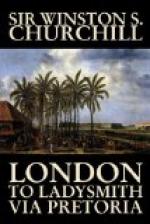The cavalry soon cleared the front, the squadrons wheeled about, the patrols retreated. The South African Light Horse, with whom I now have the honour to serve, were stationed in rear of Gun Hill, a rocky eminence so called because a heavy battery was placed there in the last engagement. From this feature an excellent view of the operation was afforded, and thence we watched the whole development.
Sir Francis Clery, General Hildyard, and their respective Staffs had also taken their position on Gun Hill, so that its crest was thickly crowded with figures peering exhaustively through field glasses and telescopes. The infantry, who were now moving steadily forward, were literally sprinkled all over the country.
In the text-books compiled from the results of past experience the military student reads that armies divide to march and concentrate to fight. ‘Nous avons change tout cela.’ Here we concentrate to march and disperse to fight. I asked General Hildyard what formation his brigade was in. He replied, ‘Formation for taking advantage of ant-heaps.’ This is a valuable addition to the infantry drill.
Meanwhile the demonstration was in progress, and not without effect. Only the well-informed realised that it was a demonstration, and the privates, as they walked phlegmatically on, did not know that they were not about to be plunged into another deluge of fire.
‘You watch it, Bill,’ I heard one man remark, ’we’ll have that —— laughing hyena’ (the Vickers-Maxim gun) ‘let off at us in a minute.’
The Boers, too, seemed to be deceived, or, at any rate, doubtful, for we could see them in twos and threes, and presently in fives and sixes, galloping into their trenches, which were evidently deep enough to shelter horse and man. It was most probable that larger bodies had already begun their countermarch from Ladysmith. We were not wasting our time or our trouble.
The infantry halted about three thousand yards from the enemy’s position, and the artillery, which numbered fourteen guns, trotted forward and came into action. All these movements, which had been very deliberately made, had taken a long time, and it was now nearly five o’clock. Dark thunder-clouds and a drizzle of rain descended on the silent Boer position, and the range of hills along which it stretched lay in deep shadow as if under the frown of Heaven. Our batteries also were ranged in this gloomy zone, but with the reserves and on the hill whence we were watching there was bright sunlight.
The bombardment and the storm broke over the Boer entrenchments simultaneously. A swift succession of fierce red flashes stabbed out from the patches of gunners, teams, and waggons, and with yellow gleams soft white balls of smoke appeared among the houses of Colenso and above the belts of scrub which extend on either side. The noise of explosions of gun and projectile came back to us on the hill in regular order, and above them rang the startling discharges of the 4.7-inch naval guns, whose shells in bursting raised huge brown dust clouds from houses, trench, or hillside. At the same time the thunder began to rumble, and vivid streaks of blue light scarred the sombre hills. We watched the impressive spectacle in safety and the sunlight.




